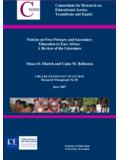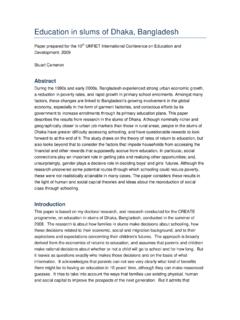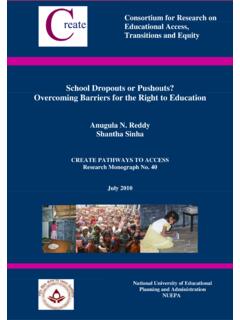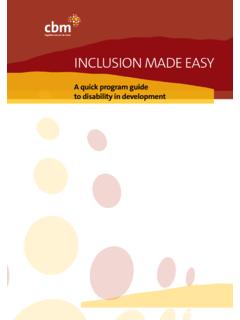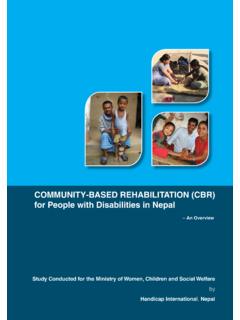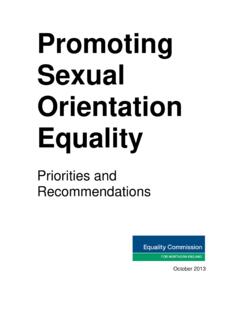Transcription of Inclusive education in India - create-rpc.org
1 Consortium for Research on Educational Access, Transitions and Equity Inclusive education in India : Interpretation, Implementation, and Issues Katharine Giffard-Lindsay CREATE PATHWAYS TO ACCESS Research Monograph No 15 September 2007 University of Sussex Centre for International education The Consortium for Educational Access, Transitions and Equity (CREATE) is a Research Programme Consortium supported by the UK Department for International Development (DFID). Its purpose is to undertake research designed to improve access to basic education in developing countries. It seeks to achieve this through generating new knowledge and encouraging its application through effective communication and dissemination to national and international development agencies, national governments, education and development professionals, non-government organisations and other interested stakeholders.
2 Access to basic education lies at the heart of development. Lack of educational access, and securely acquired knowledge and skill, is both a part of the definition of poverty, and a means for its diminution. Sustained access to meaningful learning that has value is critical to long term improvements in productivity, the reduction of inter-generational cycles of poverty, demographic transition, preventive health care, the empowerment of women, and reductions in inequality. The CREATE partners CREATE is developing its research collaboratively with partners in Sub-Saharan Africa and South Asia. The lead partner of CREATE is the Centre for International education at the University of Sussex.
3 The partners are: The Centre for International education , University of Sussex: Professor Keith M Lewin (Director) The Institute of education and Development, BRAC University, Dhaka, Bangladesh: Dr Manzoor Ahmed The National University of Educational Planning and Administration, Delhi, India : Professor R Govinda The education Policy Unit, University of the Witwatersrand, South Africa: Dr Shireen Motala The Universities of education at Winneba and Cape Coast, Ghana: Professor Jerome Djangmah The Institute of education , University of London: Professor Angela W Little Associate Partner: The Institute of Development Studies at Sussex Disclaimer The research on which this paper is based was commissioned by the Consortium for Research on Educational Access, Transitions and Equity (CREATE ).
4 CREATE is funded by the UK Department for International Development (DFID) for the benefit of developing countries and is coordinated from the Centre for International education , University of Sussex. The views expressed are those of the author(s) and not necessarily those of DFID, the University of Sussex, or the CREATE Team. Copyright CREATE 2007 ISBN: 0-901881-17-1 Address for correspondence: CREATE, Centre for International education , Sussex School of education , University of Sussex, Falmer, Brighton BN1 9QQ, United Kingdom Tel: + 44 (0) 1273 678464 Fax: + 44 (0) 1273 877534 Author Email: : Please contact CREATE using the details above if you require a hard copy of this publication.
5 Inclusive education in India : Interpretation, Implementation, and Issues Katharine Giffard-Lindsay CREATE PATHWAYS TO ACCESS Research Monograph No 15 Contents 1. 1 2. Literature 2 What is disability?.. 2 Why is disability a development issue?.. 3 EFA and children with 3 What is Inclusive education ?.. 4 Merging agendas?.. 5 3. The 7 Size and 7 Society and Culture perceptions of 8 Conceptual understandings of Inclusive education in 10 4. Implementation, Issues and 12 IE 12 Government NGO education 17 Private Administrative Inclusive education Teacher 205. 23 Policy 23 School 24 Attitudinal 25 26 6.
6 28 29 35 ii iiiAcronyms CREATE Consortium for Research on Educational Access, Transitions, and Equity DFID Department for International Development DPEP District Primary education Programme DPO Disabled People s Organisation EFA education for all IE Inclusive education IEDC Integrated education for Disabled Children MHRD Ministry of Human Resource Development MSJE Ministry of Social Justice and Empowerment NAB National Association for the Blind NCERT National Council of Educational Research and Training NGO Non-Government Organisation NIEPA National Institute of Educational Planning and Administration OB
7 Operation Blackboard OBC Other Backward Castes/Community PDA Persons with Disabilities Act PIED Project on Integrated education of the Disabled RCI Rehabilitation Council of India SC Scheduled Caste SIDA Swedish International Development Association SIDH Society for the Integrated Development of the Himalayas SSA Sarva Shiksha Abhiyan ST Scheduled Tribe UNESCO United Nations Educational, Scientific and Cultural Organisation UNICEF United Nations Children s FundInclusive education in India : Interpretation, Implementation, and Issues 1.
8 Introduction Ignorance .. is a guarantee of marginalisation. Lewin (2000: 23) In a world where approximately 113 million children are not enrolled in primary school (DFID, 2001), Lewin (2000) highlights the potential for education to reverse the negative effects of social exclusion. There are an estimated 25 million children out of school in India (MHRD 2003 statistics, cited in World Bank, 2004), many of whom are marginalised by dimensions such as poverty, gender, disability, and caste. While many educational programmes have attempted to reach out to these previously excluded children, those with disabilities are often forgotten, emphasising their invisible status in a rigidly categorised society.
9 This paper, while limited by the lack of available empirical data and constraints of desk research, aims to present a case study of the current status of Inclusive education in India with a focus on children with disabilities. It may prove useful for anyone wishing to undertake empirical research in this, until recently, neglected field, or simply needing to gain an overview of the educational situation in India today for children with disabilities. As a paper for the Consortium for Research on Educational Access, Transitions and Equity (CREATE) Pathways to Access series, it explores access issues faced by children with disabilities in the first three CREATE zones of exclusion those without any basic education access, those who drop-out after entry, and those who are at risk from exclusion (see Appendix B).
10 After exploring some general, conceptual questions concerning the relevance of disability and Inclusive education in the context of EFA, the paper analyses the interpretation and implementation of Inclusive education in India , alongside the issues and constraints faced by the stakeholders involved. This is followed by discussion of the implications these may have for the future of educational inclusion of all children, particularly those with disabilities, in the areas of government policy, school quality, attitudinal change and the potential for research. Due to word-length and data limitations, the paper was not able to explore in-depth some of the more pragmatic areas of Inclusive education implementation, such as curriculum access, assessment methods, measuring achievement, and the learning environment.

